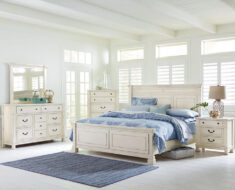
Moving to a new house is a great opportunity to ditch furniture that no longer serves and only keep what you genuinely still love. Here are five tips to help!
Moving to a new home or apartment?
Congratulations! Moving is exciting, and while it can be stressful, it’s a great feeling.
It’s a clean slate, a fresh start, and an opportunity to create the home of your dreams. It’s a chance to design a brand new space that looks and feels nothing like your old space. It’s an opportunity to reinvent yourself, express yourself in new ways, and make your home more beautiful than ever before.
But before you call the movers and start loading up the truck, you’ll need to decide which furniture to keep and what to toss away. And the more you have to move — the more expensive the move will be.
Before you pack, here are five tips on how to decide which furniture to keep for your new house.
Don’t Keep Items That Don’t Fit
You can save yourself time, money, and headaches simply by taking measurements of your new place and your old stuff.
Will the giant sectional couch in your current living room fit in your new space? Is your new dining room large enough to fit your existing dining table set? Will your bed be too big or too small for your new bedroom?
When it comes to moving furniture into a new home, there’s no point in moving items that will not fit. This is particularly important if you’re downsizing, but it’s also something to think about if you’re upgrading.
If you’re leaving a one-bedroom apartment for your dream house, your full-size bed might look miniature in your massive new master suite. Your kitchen table might not even be necessary if your new home has a built-in counter or a kitchen island with stools.
Anything that doesn’t fit — donate!
Keep Things You Love
If you love something or have an item of sentimental value, keep it. Whether it’s a family heirloom or something brand new, there’s absolutely no reason to give away or leave behind something you love (unless it doesn’t fit).
Should you find yourself in a situation where you love a particular piece but can’t fit it into your new space, offer it to friends or relatives. If you love it, they may love it just as much (and they may have the room to fit it).
Just keep in mind that the layout of your new home may change how you use an item.
For example, that armchair in your living room may make better sense as an accent chair in your new bedroom. That kitchen shelving unit you store pots and pans on might end up serving as a storage system in a pantry or closet. You may want to relocate the pull-out sofa in your living room into a room that does double duty as a home office and a guest bedroom.
No matter where you’re moving from or where you’re moving to, expect to have to repurpose some of your old furniture pieces to fit into your new space.
Keep Furniture of Value
When we say value, we’re not just talking about expensive pieces of furniture. We’re talking primarily about quality.
It’s worth paying to move your best pieces, investment pieces, and high-quality pieces. It is not worth paying for movers to move cheap or temporary furniture that isn’t well-made.
Whether you’re upgrading to your dream home or downsizing to a smaller space, it’s time to ditch your temporary furniture. By temporary furniture, we mean the milk crates you use as bookshelves, the $10 end tables from IKEA, or anything you still have from your college dorm.
The more items you need to move, the more your movers will cost. If you love that $10 IKEA end table, it will likely cost you less to buy a new one than to pay someone to move it for you.
Keep What Fits With Your Design Style
Do you have an apartment full of traditional furniture but planning to decorate your new home in a more modern style? Do you have a clean, modern place right now but want your new place to look like a rustic farmhouse?
If your current furniture doesn’t jive with the vision you have for your new place, leave it behind. Unless it’s a high-value piece that you just can’t part with, it’s usually best to buy something new that better reflects your current design style.
Yet this isn’t a hard and fast rule you need to live by.
Let’s say you want your new home to have a rustic, boho vibe. That doesn’t mean that everything has to be wood and rattan. If you have a high-quality piece made of glass or metal, you might want to keep it.
Here’s why:
There’s no need to pigeonhole yourself into one specific style. Sometimes, an eclectic grouping of pieces that “don’t go together” makes for the most exciting interior décor!
If You Didn’t Pay For It, Don’t Pay to Move It
Except for family heirlooms that have been around for generations, it’s not worth moving something you didn’t pay for.
Movers are expensive, and the more items you’re moving, the more the move will cost. Instead of spending money to move an inexpensive or free item, consider saving that money and putting it toward buying a new piece instead.
The Salvation Army, GreenDrop, Goodwill, Habitat for Humanity, and other charities across the nation pick up furniture donations for free. So don’t just put that old chair or table outside for the garbage truck to pick up. Schedule an appointment with a charity that will haul it away for free and make sure it goes to a home in need.
Conclusion
Deciding what furniture to keep for a new house means you’ll likely have to make some tough decisions. Here are some general rules to keep in mind when deciding what to keep and what to toss.
Get rid of furniture that won’t fit in your new place, doesn’t work with your design style, and isn’t worth paying to move. Keep furniture that you love that has sentimental value and that is of good quality.
With these guidelines in mind, sorting through your old stuff (and making room for new things) should be a little bit easier!
 Caitlin Sinclair is the Property Manager at The Eleanor with five years of property management experience and many more in Customer Service. She shares her passion for her community and looks forward to making The Eleanor the place to call home.
Caitlin Sinclair is the Property Manager at The Eleanor with five years of property management experience and many more in Customer Service. She shares her passion for her community and looks forward to making The Eleanor the place to call home.









































